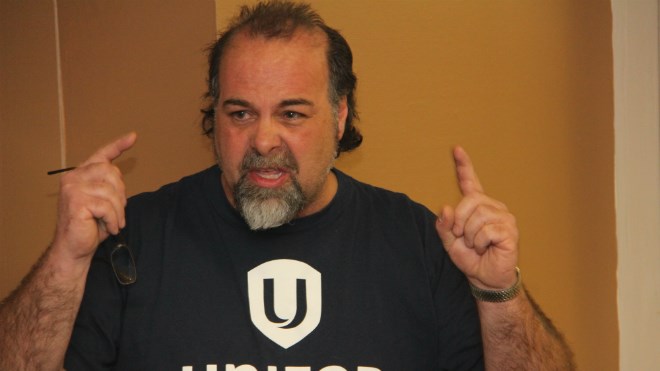Doctors had to amputate his left leg, and altered the life of the once active outdoorsman.
“You always wonder about the quality of life he could have had if he wouldn't have had that injury,” Stewart said. “Things would have been much better.”
Stewart worked as a mine development leader at Sudbury's Fraser Mine when his father was injured.
To make sure similar incidents did not happen to his coworkers, he took matters in his own hands, and became one of Unifor Mine Mill Local 598's strongest health and safety advocates.
He is now the union's health and safety co-chair and co-ordinator for the Sudbury basin.
When he addressed the mine safety review board Thursday he could not hold back tears as he recounted the story that brought him there, and pleaded for changes to prevent future workplace injuries or fatalities.
“We're lagging behind,” Stewart said. “We need to bring everything back up to today's standards. We're not mining in the 1960s and 1970s anymore.”
Stewart said mining should be recognized as a skilled trade to ensure new workers have the in-depth training required to be effective at their jobs, and make health and safety a central part of their workplace philosophy.
He said if new miners had to complete a 6,000-hour apprenticeship, part of that time could be dedicated to the internal responsibility system.
Denis Chartrand, Unifor Mine Mill Local 598's compensation officer, echoed Stewart, and highlighted the importance of health and safety education at an early age.
Chartrand advocated for high school curriculums to include health and safety components. He said students need to be aware of their three main rights in the workplace: the right to know; the right to refuse dangerous work; and right to be educated.
Chartrand also shared his concerns about airborne pollutants that have been introduced to modern mines from the diesel engines in the machinery and the silica quartz mixed into cement, which can cause lung damage if the dust is inhaled.
He said mining companies need to do in-depth risk assessments for any new technologies and cannot have their employees simply rely on personal protection equipment, such as masks, to ensure they do not develop chronic obstructive pulmonary disease or lung cancer after decades on the job.
From a research perspective, Tammy Eger, director of Laurentian University’s Centre for Research in Occupational Health and Safety, said mining companies and governments must invest more to research how new technologies work after they are implemented.
Eger said new health and safety technologies are not evaluated enough after they have been developed and applied to operational mines.
“We really think research can help drive prevention,” she said.
Vic Pakalnis, president and CEO of Mining Innovation, Rehabilitation and Applied Research Corporation (MIRARCO), said technology can improve mine health and safety training.
He said Australia has led the field, and has implemented virtual reality to compliment the training miners receive underground.
In addition to Sudbury, the Ministry of Labour's review of mine safety has held public consultations in Timmins and Kirkland Lake. Further consultations are planned for Red Lake on April 30; in Marathon on May 1; and in London, on May 13.
The ministry has sought for input on the role of health and safety system partners; the internal responsibility system; technology and the management of change; training, skills and labour issues; health and safety hazards in the mining sector; and emergency preparedness and mine rescue.
George Gritziotis, Ontario's chief prevention officer and the mine safety review's chair, is expected to release a mid-review report in June or July, and will release a final report after the review is completed, at the end of 2014.
The review will recommend amendments to government regulations where appropriate.
Join Sudbury.com+
- Messages
- Post a Listing
- Your Listings
- Your Profile
- Your Subscriptions
- Your Likes
- Your Business
- Support Local News
- Payment History
Sudbury.com+ members
Already a +member?
Not a +member?
Sign up for a Sudbury.com+ account for instant access to upcoming contests, local offers, auctions and so much more.
